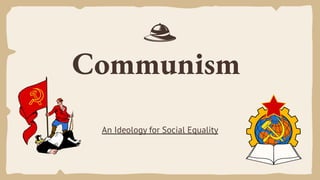
Communism.pdf
- 1. Communism An Ideology for Social Equality
- 2. Table of the contents 1 Introduction 2 Key Figures in Communism 3 Principles of Communism 4 Historical Background 5 The Communist Manifesto 6 The Soviet Union
- 3. 7 Chinese Communism 8 Cuban Communism 9 Variations of Communism 10 Achievements of Communism 11 Criticisms of Communism 12 Dissolution of Communist States 13 Contemporary Communist Movements 14 Challenges to Communism 15 Lessons Learned 16 Contemporary Views
- 4. 17 Impact on Political Thought 18 Cultural Impact 19 Conclusion 20 Additional Resources 21 Discussion Questions 22 Thank You!
- 5. It aims to abolish private ownership of the means of production and promote collective ownership. Communism is a socio-economic ideology that advocates for the establishment of a classless society. Introduction
- 6. Key Figures in Communism Karl Marx: Co-authored "The Communist Manifesto" and developed the theory of communism. Friedrich Engels: Collaborated with Marx and expanded upon communist ideas. Vladimir Lenin: Led the Bolshevik Revolution and established the Soviet Union.
- 7. Principles of Communism Common Ownership: The means of production and resources are owned and controlled collectively by the community. Social Equality: Communism seeks to eliminate social classes and ensure equal distribution of wealth and resources. Cooperative Living: Collaboration and mutual support among individuals are emphasized.
- 8. Historical Background Origins: Communism emerged as a response to the Industrial Revolution and the socio-economic inequalities it created. The Bolshevik Revolution in 1917 led to the establishment of the Soviet Union as the first communist state. Origin Russian Revolution:
- 9. The Communist Manifesto ● Published in 1848 by Marx and Engels. ● Outlines the goals and principles of communism. ● Critiques capitalism and predicts its eventual downfall.
- 10. The Soviet Union The Bolsheviks seized power in 1917, establishing the Soviet Union. Centralized economic planning was implemented, with the state controlling production and distribution. Under Joseph Stalin, the Soviet Union experienced rapid industrialization but also political repression. Rise of Communism: Stalin Era: Planned Economy:
- 11. Chinese Communism Led the Chinese Communist Party and established the People's Republic of China in 1949. Mao's economic and social campaign resulted in widespread famine and economic setbacks. Mao Zedong: Great Leap Forward: Cultural Revolution: A period of social and political upheaval aimed at purging capitalist elements.
- 12. The Cuban government faced trade embargoes and political tensions with the U.S. Cuban Communism Led the Cuban Revolution and established a communist state in 1959. Fidel Castro: Relationship with the United States:
- 13. Achievements of Communism Communist regimes have often prioritized healthcare, education, and social welfare. Some communist countries experienced rapid industrialization and infrastructure development. Many communist states promoted gender equality and women's rights. Improved Living Conditions: Gender Equality: Economic Development:
- 14. Variations of Communism Communism has been implemented in various forms across different countries, with adaptations and variations. Titoism in Yugoslavia emphasized self-management and worker cooperatives. A trend in Western Europe that sought to reconcile democratic principles with communist ideals. Different Paths: Eurocommunism: Yugoslav Model:
- 15. Criticisms of Communism Critics argue that communism restricts personal liberties and suppresses dissent. Critics contend that communism fails to account for human self-interest and the need for incentives to drive productivity. Centralized planning and lack of market mechanisms can lead to resource misallocation and inefficiencies. Lack of Individual Freedom: Economic Inefficiency: Human Nature:
- 16. Eastern Europe: Soviet Union: Dissolution of Communist States The fall of the Berlin Wall in 1989 and subsequent events led to the collapse of communist regimes in Eastern Europe. Dissolved in 1991, marking the end of the world's first communist state.
- 17. Contemporary Communist Movements Many countries still have communist parties participating in politics. Some small-scale communist communities exist, advocating for alternative living and social structures. Communist Parties: Niche Movements:
- 18. The dominance of capitalist economies poses challenges to the spread of communism. Global Capitalism: Ideological Critiques: Critics argue that communism ignores the importance of individual liberty and property rights. Globalization Increasing interconnectedness and global trade have shaped the economic landscape. Challenges to Communism
- 19. The persistence of wealth disparities highlights the ongoing relevance of discussions around social equality and wealth distribution. Lessons Learned Studying communism helps us understand its successes, failures, and the complexities of socio-economic systems. Reflection on History: Inequality:
- 20. Contemporary Views Many countries have adopted mixed economic systems, combining elements of capitalism and socialism. Welfare states and progressive policies influenced by socialist principles are prevalent in many democratic countries. Mixed-Market Economies: Social Democracy
- 21. Impact on Political Thought Communist ideas have shaped political discourse and the development of alternative ideologies. Communism's critique of capitalism has influenced discussions on inequality and social justice. Influence on Political Spectrum: Critiques of Capitalism:
- 22. Cultural Impact Communist ideologies have inspired works of art, literature, and film. Iconic symbols such as the hammer and sickle are associated with communism. Art and Literature: Symbols and Imagery:
- 23. Conclusion ● Communism is a socio-economic ideology that aims for a classless society with collective ownership. ● Its historical implementation has varied, with both achievements and challenges. ● Understanding communism helps us analyze social systems and engage in meaningful discussions on equality and justice.
- 24. Additional Resources 1. "The Communist Manifesto" by Karl Marx and Friedrich Engels 2. "The Soviet Experiment: Russia, the USSR, and the Successor States" by Ronald Grigor Suny 3. "Mao: The Unknown Story" by Jung Chang and Jon Halliday 4. "The Cuban Revolution: Origins, Course, and Legacy" by Marifeli Pérez-Stable
- 25. ● What are the core principles of communism? ● What were the main achievements and challenges faced by communist states? ● How has the fall of communism impacted global politics and economies? ● Can elements of communism be integrated into contemporary societies? ● How does communism compare to other socio-economic ideologies? Discussion Questions
- 26. CREDITS: This presentation template was created by Slidesgo, and includes icons by Flaticon, and infographics & images by Freepik Thanks! Do you have any questions? aspofficial1999@gmail.com